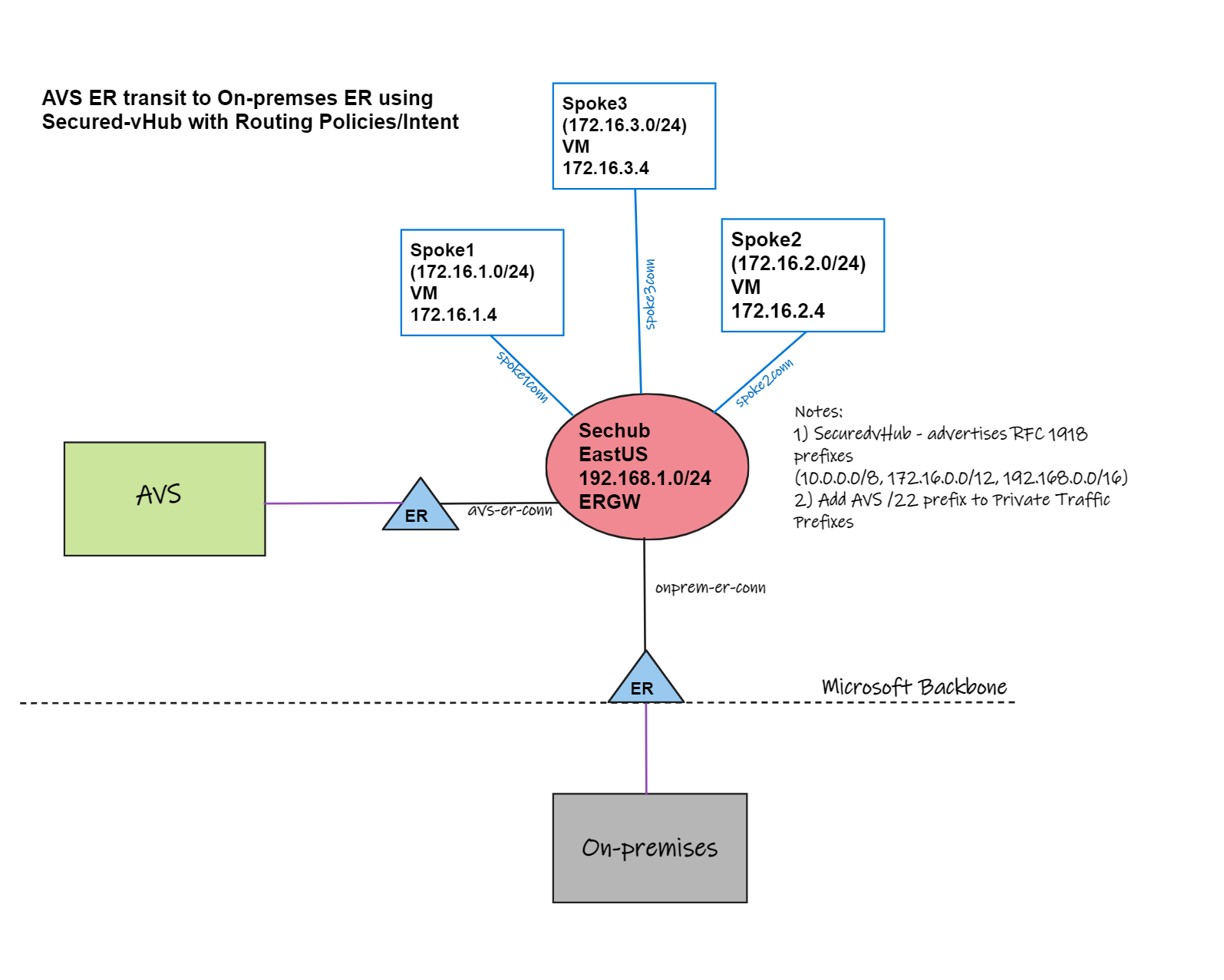Articles and labs
- LAB1: AVS (ER) to On-prem (ER) transit using Secured-vHub+Routing Intent
- LAB2: AVS (ER) to On-prem (VPN) transit using Secured-vHub+Routing Intent
Lab deployment script:
wget -O svh-avs-er-deploy.sh https://raw.githubusercontent.com/dmauser/azure-vmware-solution/main/svh-er-transit/svh-avs-er-deploy.azcli
chmod +xr svh-avs-er-deploy.sh
./svh-avs-er-deploy.shPlease, run the script above via Azure Cloud Shell (Bash) or Azure CLI on Linux.
Default variables:
#Parameters
region=eastus
rg=lab-svh-avs # set your Resource Group
vwanname=svh-avs # vWAN name
hubname=svhub # vHub name
username=azureuser # Username
password="Msft123Msft123" # Please change your password
vmsize=Standard_B1s # VM Size
firewallsku=Premium #Azure Firewall SKU Standard or Premium- ExpressRoute Local SKU.
- Lack of Global Reach feature.
- Traffic inspection between AVS and On-premises is required.
- ExpressRoute Circuits are not created as part of this lab.
- You must open a support ticket to enable ER to ER transit using Azure Virtual WAN + Routing Intent. See: Transit connectivity between ExpressRoute circuits with routing intent.
- After connecting the AVS ExpressRoute Circuit, go to Firewall Manager - Security Configuration and enable secure Internet Traffic to allow the default route (0.0.0.0/0) to be advertised to the AVS environment.
- Add AVS /22 prefix inside the Private traffic prefixes.
- Review carefully all the considerations when enabling routing policies/intent by reviewing Virtual WAN Hub routing intent and routing policies - Troubleshooting data path. Especially RFC 1918 prefixes (10.0.0.0/8, 172.16.0.0/12, 192.168.0.0/16) which are advertised by default from Secured-vHUB. If the On-premises ExpressRoute circuit already advertises those prefixes, routing adjustments must be made before enabling Routing-Intent.
- In case customer is already advertising RFC 1918, before enable Routing Intent is important to break them in two halves (more specific) on the customer side to ensure they can keep attracting private traffic from Azure to their on-premises network. Here is how that breakdown should be: 10.0.0.0/9, 10.128.0.0/9, 172.16.0.0/13, 172.24.0.0/13, 192.168.0.0/17, 192.168.128.0/17.
Lab deployment script:
wget -O svh-avs-vpn-er.sh https://raw.githubusercontent.com/dmauser/azure-vmware-solution/main/svh-vpn-er/svh-avs-vpn-er.azcli
chmod +xr svh-avs-vpn-er.sh
./svh-avs-vpn-er.shPlease, run the script above via Azure Cloud Shell (Bash) or Azure CLI on Linux.
Default variables:
#Parameters
region=southcentralus
rg=lab-svh-vpner # set your Resource Group
vwanname=svh-avs-vpner # vWAN name
hubname=svhub # vHub name
username=azureuser # Username
password="Msft123Msft123" # Please change your password
vmsize=Standard_B1s # VM Size
firewallsku=Premium #Azure Firewall SKU Standard or Premium